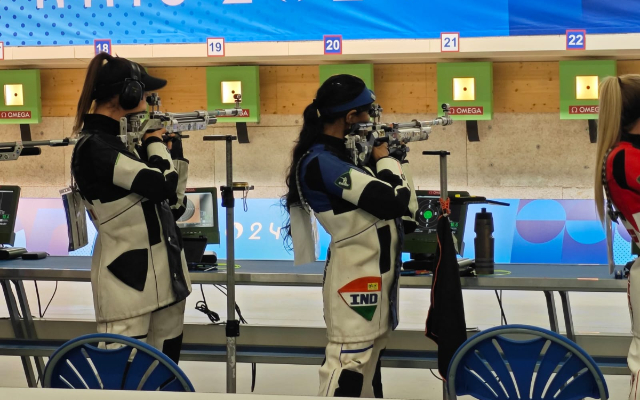
In the caverns of my brain lives the tension and drama of following the women’s 10m Air Rifle qualifying round. For almost an hour, your eyes zoomed in on Elavenil Valarivan’s name – A 25-year-old shooter from Cuddalore. After all, she was consistently in the top four in the rankings and once took the pole position. And then, something happened. Elavenil suddenly slipped to 8th place. Eventually, she couldn’t progress to the final, ending up a disappointing 10th.
Just think of the narrow margins. After around 50 shots, she was ranked fourth. And then came the heartbreaking moment. She shot 9.8 in the final series. A difference of 0.6 was enough to ensure Elavenil’s elimination. In the same event, there was another Indian shooter – Ramita Jindal. After the first series, she was placed 21st. And then she steadily made her way into the top 10 before sealing a spot in the summit clash with a 105.7. It was fifth place for Ramita.
Ramita hugged her coach, Suma Shirur, as the Indians in the shooting arena started to celebrate. Just some meters away was Elavenil. After a discussion with the coach, all she could do was just take her seat and stare at the scores. It is very difficult to imagine what she might have gone through at that very moment.
In the Tokyo Olympics, too, she made an exit in the qualifying round. So, hours of training, hours of studying different techniques of controlling breathing and putting it into practice meant virtually nothing. All it took was a matter of a few minutes for those dreams to disappear into thin air. To make matters worse for the Indian shooting contingent, Sarabjot Singh also missed out on a berth in the 10m Air Pistol individual event by a whisker.
For a moment, rewind back to the Tokyo Olympics. In that mega event, there was one more brilliant shooter in Saurabh Chaudhary. He was touted as India’s next big hope. Unfortunately, his dreams too were shattered. Where is he now? Last heard, he was struggling to make it to the final of National Games and National Championships. He didn’t qualify for the Asian Games either. From being known as the ‘invincible’ to cheering his teammates at the Nationals, he is now lost in a morass of loneliness.
The larger picture to capture here is the brutality of this sport. In tennis, there are Grand Slams. In football, the World Cup trophy is easily the biggest prize. It is true that shooting also has its own World Cups and World Championships. But let’s be honest that in shooting, the Olympics is the one and only pinnacle of the sport. In that context, one has to look at failure from a slightly different context. Just one or two poor shots and you could be facing elimination from the one event that matters the most, the Olympics.
Also, comparing the Indian athletes with the Chinese ones isn’t exactly right. There is a sizeable difference in terms of China’s public expenditure on sports when compared to the kind of resources India allocate to its athletes. The tinge of sadness surrounding Saurabh’s decline also indicates India don’t have the necessary support system when an athlete is going throw a low phase. China have set its own standards. India still have to build a culture for sports.
It wasn’t all doom and gloom for India’s shooters. Manu Bhaker, who too lost her way in Tokyo, showed resilience with a stellar showing in Paris, clinching a bronze. Manu and Sarabjot also made it through qualification in the 10m air pistol mixed-team event. Maybe, Sarabjot can still turn his tears of pain into tears of joy in the bronze medal match tomorrow. Even if he doesn’t, he is still an Olympian. An Olympian who gave his all in training and during the event. The same can be said about Elavenil and the rest.



